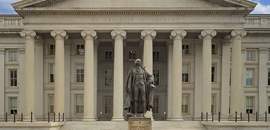- Investor optimism that the Federal Reserve is about to ease monetary policy has propelled the U.S. stock market to a record high. However, some have questioned how long this can continue when corporate profits in the first half of this year are estimated to be down marginally.
- Thus far, investors have looked past the earnings slump, believing it is temporary. However, an article by The Economist challenges this view.1 It contends the secular rise in corporate profits relative to GDP of the past 25 years is over.
- Our take is that profit growth in the next 12 months is likely to be below average, as the slowdown in the global economy lingers. If so, the stock market could experience a correction. However, it is premature to declare an end to the secular trend in profit growth and we do not foresee an imminent bear market.
Investors Fixate on the Fed While Profits Slump
The bull-run in the U.S. stock market that began in March 2009 continues to set a record for longevity, and now for cumulative market rise as measured by the S&P 500 Index (Figure 1). It has defied virtually all forecasts by generating returns in the vicinity of 20% this year, even though profits have been soft. According to Factset, earnings for the S&P were slightly negative in the first quarter (-0.4% over a year ago) and expectations are for a similar outcome in the second quarter.
Figure 1: Bull Markets in the Post-WWII Era
| start date | duration in months | S&P 500 Increase |
|---|---|---|
| June 1949 | 86 | 266% |
| October 1957 | 50 | 86% |
| June 1962 | 44 | 80% |
| October 1966 | 26 | 48% |
| May 1970 | 32 | 74% |
| October 1974 | 74 | 126% |
| August 1982 | 60 | 229% |
| December 1987 | 31 | 65% |
| October 1990 | 113 | 417% |
| October 2002 | 60 | 102% |
| March 2009 | 123 | 450% |
For some observers, the combination of strong equity returns and soft profits appears to be an anomaly. However, while there is a close relationship between the stock market and profits over the long run, the linkage over the short term is varied and valuations may rise or fall in the interim. During 2018, for example, the S&P 500 Index fell by 4.4%, even though profit growth exceeded 20%, with corporate tax cuts estimated to have boosted overall earnings by about eight percentage points. As a result, the price-earnings multiple on a one year forward basis declined to 14.4 times earnings from 18.2 times in 2017.
The opposite pattern is evident so far this year: The stock market’s surge amid flat earnings has resulted in the market multiple rising to 17.2 times one year forward earnings. The principal reason is investors anticipate the Fed is about to ease monetary policy, which they believe will help extend the economic expansion. By comparison, in 2018 investors were concerned that the Fed could undermine the expansion if it continued to tighten policy.
For the time being, investors are looking past the near-term profit slump. Many view it as a temporary slowdown such as occurred in the first half of 2016. They are counting on Fed ease and an eventual lessening in trade tensions to revive U.S. and global growth in the second half and beyond.
Is the Boom in Profits Over?
The Economist article mentioned above challenges this sanguine view. It contends there are both secular and cyclical reasons to expect a slowing in U.S. profit growth in the years ahead.
The article begins by noting that over the past 25 years worldwide earnings of American companies have risen by 455%, and they are now 35% above their long-term average relative to GDP. The key factors contributing to the surge are the following: (i) globalization, (ii) tepid wage increases, and (iii) the ascent of technology as evinced by the rise of FAANGs (Facebook, Amazon, Apple, Netflix, and Google).
Looking ahead, the article points to changes in each of these factors that suggest slower profit growth relative to GDP ahead. One is that the effects of globalization are waning: “The share of pre-tax earnings made abroad has slipped from 35% a decade ago to 25%. Company conference calls with investors now feature discussions about trade wars.” A second is the tightening of the jobs market is contributing to upward pressure on wages, which is likely to cut into profit margins at some point. Third, growth rates of some of the high flying tech stocks – notably Alphabet and Facebook – are slowing, and the next generation of tech stars, such as Uber and Netflix “burn up cash rather than print it.”
On the cyclical side, the article contends that equity-fund managers and Wall Street analysts who expect a profits rebound later this year are likely to be disappointed. One reason is that companies have geared up their balance sheets to take advantage of low interest rates, and 40% of corporate debt outstanding is owed by highly-leveraged firms, with debts over four times their gross operating profits. Consequently, they are especially vulnerable if U.S. growth slows.
Our Take: Two Concerns & a Big Unknown
My own view is the slowdown in the global economy is likely to linger well into next year. This, in turn, implies U.S. corporate profits will remain sub-par into next year.
I am less optimistic than most equity investors, but for different reasons than The Economist cites. My principal concern is that investors are over-estimating the impact that policy easing by the Fed and other central banks will have on the U.S. and global economy. With U.S. interest rates in the vicinity of 2% and rates in Europe and Japan near or below the zero bound, further central bank policy easing is unlikely to materially boost aggregate demand. Banks currently are flush with excess reserves and businesses are unlikely to increase capital spending with rates already exceptionally low. The main channel through which monetary policy operates in these circumstances is to enhance asset values. However, this also increases the risk of asset bubbles.
My second concern is that the current truce in the U.S. trade war with China still leaves businesses facing heightened uncertainty about how it will be resolved. Should the stalemate persist into next year, as seems likely, there is little reason to expect a revival in global trade and manufacturing. If the trade war were to escalate, the outcome would be worse: It would increase the risk of recession in Europe, Japan, Mexico and other key emerging economies, which at some point could spill over to the U.S.
Beyond this, it is premature to have a strong view about whether the secular trend in corporate profits relative to GDP is about to change. Such changes – upward or downward – typically are accompanied by shifts in U.S. productivity growth. However, economists have a poor understanding of what drives such shifts. In fact, one of the surprises this year is that productivity has improved after being sub-par throughout most of the expansion. While the improvement has helped keep unit labor costs flat despite a gradual increase in wages, it is simply too early to tell whether this uptick will continue or be reversed.
Investment Implications: A Pullback Is Possible, but No Bear Market
Weighing these considerations, we believe the recent profit slump and the prospect for sub-par growth in profits over the next 12 months leaves the market vulnerable to a correction of 10%-20%, as happened last year. A bear market, however, is less likely, because barring an escalation in the trade conflict the U.S. economy does not appear headed for a recession. Also, while valuations have become somewhat stretched, they are still within a normal range. Accordingly, we are nearly fully invested in our equity portfolios, while favoring companies with high long-term earnings potential and strong balance sheets.
1 The Economist, “Soaring Stock Market, Peaking Profits," July 18, 2019.

















